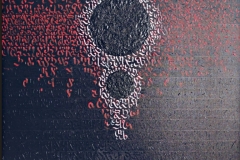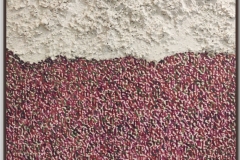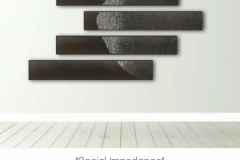Bhavish Ahuja, is a Contemporary Artist, based out of New Delhi. A honors degree in Physics and a Masters in Computing Science from England, he had been living, working and travelling all across Europe and New Zealand for almost a decade. In 2011, after years of experience working as an I.T Consultant, when the work got monotonous, he left everything and came back to his grounds in India and settled back permanently in pursuit for his inner calling. He started with taking up abstract Photography and building his compositional work. After exhibiting in some of the prestigious galleries in India, he got great recognition for his work that propelled him to continue further. He was chosen as the only self-taught Artist to exhibit, by the jury of Lalit Kala Akademy headed by Professor. Akre.
His series of colorful abstract compositions were well recieved by the critics and buyers. Shapes and forms on inanimate objects led to find cognition in alphabetical compositions. And that further led to his works in self-evolved abstract Calligraphy which his current series inherits.
In his own words, the Artist says:
“Everything that is confined into a restricted space and time and then condensed further, gives it a form of solidarity. Solidarity that gives rise to an egoist, relentlessly stubborn and perfectly stable significant other. Birth of this new form, from an existing form, just by this new laid uncomfort is seen in everything that nature has presented before us. Just like rock and water droplets are born from this epiphany, the very essence of this confinement is the beginning of new complexes of the same “it”. Losing and gaining becomes inturn a play to consummate complexities, bringing new shapes and forms, newer identities from the existing alreadies, for better or worse, who knows. I restricted myself to only a few solid colors and shapes and challenging myself on meditating more – to bringforth yet newer pieces. Each piece is an exercise to persistently and relentlessly meditate until the very completeness starts to shine through. With no association with the Art Fraternity either through art education or acquaintance, this lack of belonging in-turn gifts me with a unique association with the self where every piece created is governed completely by the subconscious inner me. I have no bounds in the usage of any material, colors or concepts. I let myself be used as a tool, by the inner self, to create newer and deeper stories and concepts and manifest unfathomable realities and my existence gets confined only to this spiritual language you see in my works. I flow with these lines and settle in these shapes, resting for a while and speak a language that is unspeakable. – Bhavish Ahuja.”
About my works:
“My work revolves around metaphysical subjects and I use abstract symbols to create a symphony of sorts, playing with colors, forms and textures. Primarily, when I had started working on these, one could see a lot of Mantras and familiar alphabets from languages such as English, Hindi and few more ancient symbols, which in a way was a projection of my inner self, my experiences of what I have seen and felt. Now, with exhausting these onto surfaces, across many artworks, these symbols take a new form organically and while they still have their roots of a language, they turn into something of unique shape and form. This new form dances between being something & nothing. Somewhere, it also symbolises acquired or composite alreadies
Gradually, these have evolved into abstract forms, reorganizing themselves, sometimes with an overlap, at times with a fade, an overlining or having a root, texture, a skin, a connect – to represent the silent noise of myraid thoughts within the subconscious.
These thoughts have a hissing whisper that cannot be heard nor can these thoughts be read or seen. This ocean of uncountable thoughts can only be felt or they hint in a particular direction, that one can experience mind moving towards. My works usually takes this visual depiction or thought narrative to express a dialog between oneself and its metaphysical surroundings.I call this a written art of Soliloquies, speaking of what is unspoken.”



